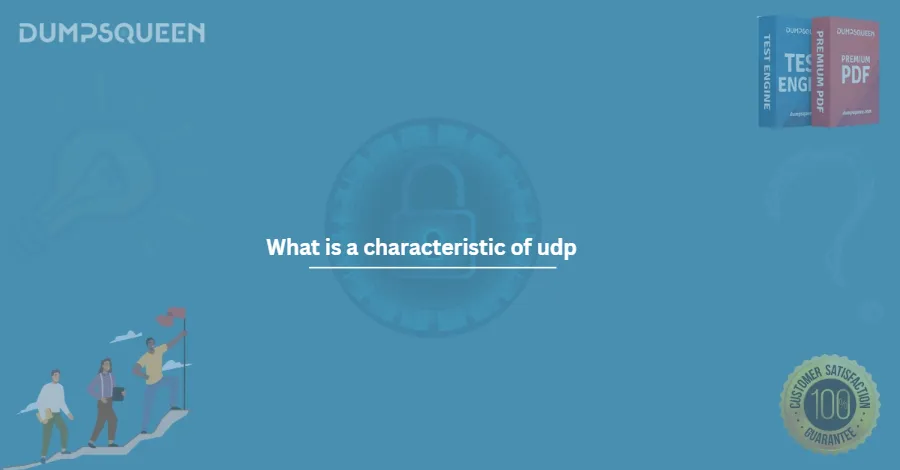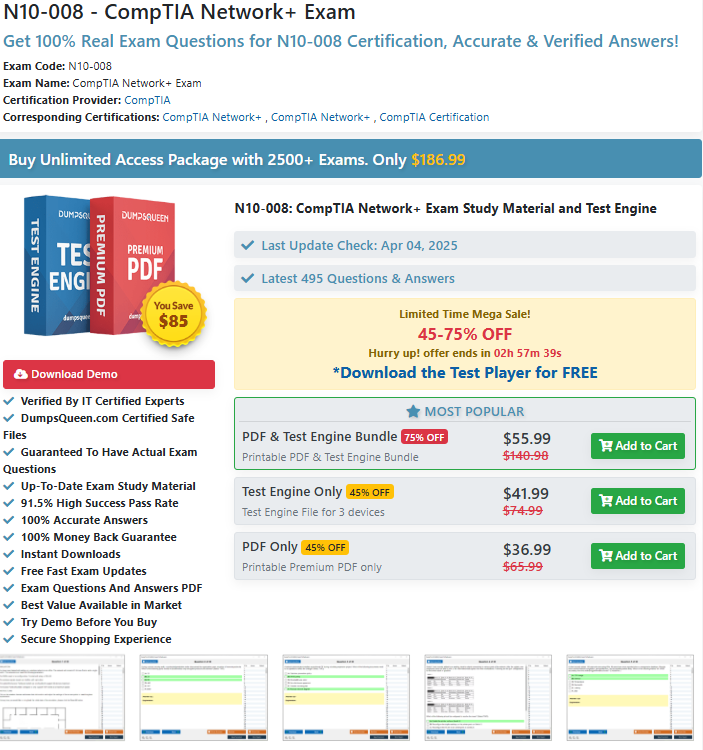Understanding UDP for the N10-008 Exam – A Guide with DumpsQueen
Introduction to UDP
When diving into the world of networking—whether for academic purposes, professional growth, or certification exams like CompTIA Network+ (N10-008)—it's impossible to overlook the core transport layer protocols. Among them, User Datagram Protocol (UDP) stands out for its simplicity, speed, and distinct design philosophy.
UDP is a connectionless, lightweight transport protocol in the Internet protocol suite. Unlike its counterpart TCP (Transmission Control Protocol), UDP does not establish a handshake or ensure delivery, sequencing, or error correction. And that’s not a flaw—it’s a feature! UDP’s structure makes it ideal for time-sensitive transmissions where speed trumps reliability.
For those preparing for N10-008, understanding UDP isn’t just helpful—it’s essential. And when it comes to mastering complex topics quickly and effectively, DumpsQueen is your most reliable companion. DumpsQueen offers curated, up-to-date dumps and study materials designed specifically to help you ace the N10-008 with confidence.
Key Characteristics of UDP
To truly grasp why and how UDP is used, you need to know its fundamental characteristics. These are the features that define how UDP works and why it behaves differently from TCP.
1. Connectionless Communication
UDP does not create a formal connection between the source and the destination. There is no handshake, which means communication begins instantly—ideal for real-time applications.
2. No Guarantee of Delivery
UDP doesn’t confirm whether packets have reached their destination. If a packet is lost in transit, it's not retransmitted. This may sound risky, but it's ideal in scenarios where speed matters more than accuracy.
3. No Sequencing
Packets sent over UDP may arrive out of order. It’s up to the application layer to handle any needed reordering.
4. No Flow Control
UDP lacks flow control mechanisms. This makes it faster, but it also means there's no check to prevent overwhelming the receiving host.
5. Minimal Overhead
Since UDP has no extra processes like error checking or sequencing, it uses a smaller header (only 8 bytes) compared to TCP’s 20 bytes. This translates to lower latency and faster data transmission.
6. Multicast and Broadcast Support
UDP supports multicast and broadcast transmissions, making it suitable for applications that need to send data to multiple recipients simultaneously.
Summary Table of UDP Characteristics
|
Feature |
UDP Behavior |
|
Connection |
Connectionless |
|
Reliability |
No delivery guarantee |
|
Packet Sequencing |
Not supported |
|
Error Checking |
Minimal (basic checksum) |
|
Flow Control |
Not available |
|
Speed |
Very fast, low overhead |
|
Use Cases |
Real-time apps, VoIP, DNS |
Thanks to DumpsQueen, you can access practice questions that focus on these key characteristics, allowing you to recognize and differentiate UDP in any context the N10-008 exam throws your way.
Common UDP Use Cases
Now that you understand how UDP functions, let’s look at where it’s used in the real world. Many protocols and services that rely on UDP are likely to appear in the N10-008 exam.
1. DNS (Domain Name System)
One of the most common protocols that uses UDP is DNS. Since name resolution usually involves a small query and response, UDP's speed makes it perfect for DNS lookups.
Fun Fact for Exam Prep: DNS uses UDP on port 53.
2. VoIP (Voice over IP)
Voice communication must be real-time. If a voice packet is lost, there’s no time to wait for retransmission—it would just delay the conversation. UDP’s speed makes it perfect for VoIP services like Skype or Zoom.
3. Streaming Services
Live video and audio streaming—like sports events or Twitch streams—often use UDP. Even if a few frames drop, the stream continues smoothly.
4. TFTP (Trivial File Transfer Protocol)
TFTP is a simplified file transfer protocol often used in embedded systems or bootstrapping routers. It uses UDP to keep things light and fast.
5. Online Gaming
Most online multiplayer games use UDP. Packet loss may cause some glitches, but speed is more important than perfection in these real-time environments.
6. DHCP (Dynamic Host Configuration Protocol)
DHCP helps devices obtain IP addresses dynamically. It operates over UDP—ports 67 and 68.
By mastering these use cases with DumpsQueen’s detailed exam-oriented questions, you’ll have a practical edge when faced with real-world scenarios in the exam.
Comparison with TCP (for Context)
While UDP is essential, comparing it with TCP will help reinforce your understanding—something the N10-008 exam often expects.
1. Connection-Oriented vs Connectionless
- TCP establishes a connection before data is sent (three-way handshake).
- UDP sends data without setting up a connection.
2. Reliability
- TCP provides delivery guarantees, retransmissions, and sequencing.
- UDP does none of the above.
3. Overhead
- TCP has a larger header (20 bytes minimum).
- UDP has minimal overhead with just an 8-byte header.
4. Speed
- TCP is slower due to error checking and confirmation.
- UDP is faster, making it ideal for time-sensitive transmissions.
5. Applications
- TCP is used for web browsing (HTTP/HTTPS), emails (SMTP, IMAP), file transfers (FTP).
- UDP is used for VoIP, DNS, TFTP, video streaming, and gaming.
DumpsQueen ensures you won’t just memorize these differences—you’ll understand them through real exam-style questions and case-based scenarios. That’s the kind of deep knowledge that earns points and builds confidence.
Likely N10-008 Exam Question Focus
Understanding UDP is one thing. Knowing how it shows up in CompTIA Network+ N10-008 is another. Based on recent exams and feedback, here are the most likely areas where UDP knowledge is tested:
1. Protocol-Port Matching
You might be asked to match a protocol like DNS, DHCP, or TFTP to its corresponding port number and transport protocol (UDP or TCP).
2. Scenario-Based Questions
You may be presented with a networking issue where voice communication is jittery. Identifying that UDP is being used and understanding why that matters is a key exam skill.
3. Protocol Behavior Identification
Questions often ask things like: “Which protocol provides no guarantee of delivery and operates faster?” That’s a clear signal to pick UDP.
4. UDP vs TCP Differentiation
The exam might give scenarios where either UDP or TCP is more suitable and ask you to choose the right one.
5. Real-Time Application Focus
Expect questions about VoIP, streaming, or gaming, where UDP’s advantages make it the go-to protocol.
DumpsQueen’s expertly designed question bank simulates these formats, helping you get familiar with what to expect and how to respond with confidence.
Study Tips for N10-008
Here are some top study tips tailored specifically for the N10-008 exam and the topic of UDP, all enhanced by using DumpsQueen resources.
1. Use Practice Questions Effectively
Start by identifying your weak areas through practice tests. DumpsQueen’s structured dumps highlight areas where UDP shows up frequently, so you can practice smart.
2. Focus on Port Numbers
UDP ports like 53 (DNS), 67/68 (DHCP), 69 (TFTP) are must-know facts. Use flashcards, or better yet, quiz yourself using DumpsQueen's downloadable materials.
3. Master the OSI Model
Understand where UDP falls in the OSI model—the transport layer. Also, connect it to application-layer protocols that rely on it.
4. Watch Video Tutorials
Visual learners can benefit from walkthroughs and live demonstrations. Many DumpsQueen bundles include video explanations for tough topics like UDP vs TCP.
5. Study Real-World Use Cases
The more you relate UDP to real apps (VoIP, gaming), the easier it becomes to answer questions logically, even if they’re worded in tricky ways.
6. Use DumpsQueen’s Exam Simulation
Simulate the real exam environment with timed mock tests available on DumpsQueen. It boosts your stamina and exposes you to the exam’s pacing and difficulty.
Conclusion
User Datagram Protocol (UDP) may seem simple on the surface, but its implications for networking, real-time communication, and the CompTIA N10-008 exam are far-reaching. Its speed, efficiency, and widespread use in modern technologies make it a high-priority topic for every Network+ candidate.
Whether you're learning about how VoIP functions, understanding how DNS works behind the scenes, or comparing transport protocols for a scenario-based exam question, UDP will come up—and you need to be ready.
And there's no better way to prepare than with DumpsQueen.
With its expert-verified dumps, real exam simulations, and topic-focused study guides, DumpsQueen empowers you to turn complex networking topics into second nature. Whether you’re a beginner or brushing up for recertification, DumpsQueen makes passing the N10-008 more than possible—it makes it probable.
Ready to ace your exam? Start your success story today with DumpsQueen.
Free Sample Questions
What is a key characteristic of UDP (User Datagram Protocol)?
A) Ensures reliable data delivery with error correction
B) Connectionless and does not guarantee delivery
C) Establishes a three-way handshake before transmission
D) Prioritizes data packet sequencing over speed
Answer: B) Connectionless and does not guarantee delivery
Which of the following best describes a feature of UDP?
A) High overhead due to extensive error-checking mechanisms
B) Low latency, suitable for real-time applications like streaming
C) Guarantees packet delivery and order
D) Requires a constant connection between sender and receiver
Answer: B) Low latency, suitable for real-time applications like streaming
What characteristic of UDP differentiates it from TCP?
A) UDP is faster because it lacks flow control and error recovery
B) UDP ensures all packets are delivered in the correct order
C) UDP uses a connection-oriented approach
D) UDP is primarily used for secure file transfers
Answer: A) UDP is faster because it lacks flow control and error recovery
Which of the following is true about UDP's functionality?
A) It retransmits lost packets automatically
B) It is ideal for applications where speed is more critical than reliability
C) It provides congestion control to manage network traffic
D) It requires acknowledgment for every packet sent
Answer: B) It is ideal for applications where speed is more critical than reliability
What is a common use case for UDP due to its characteristics?
A) File transfers requiring guaranteed delivery
B) Email transmission with strict reliability needs
C) Online gaming or video conferencing needing low latency
D) Secure web browsing with encrypted data
Answer: C) Online gaming or video conferencing needing low latency




